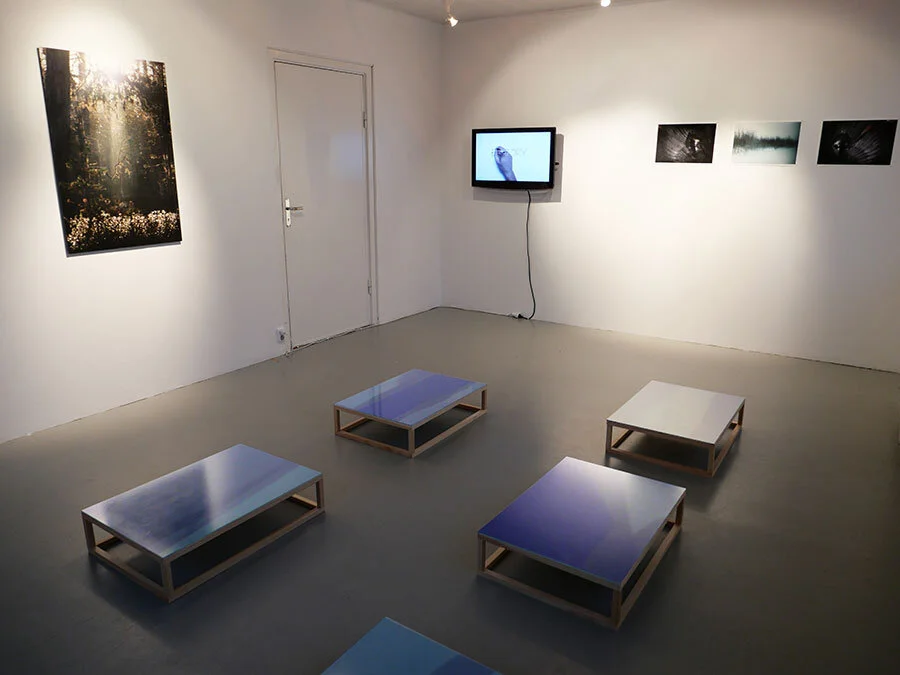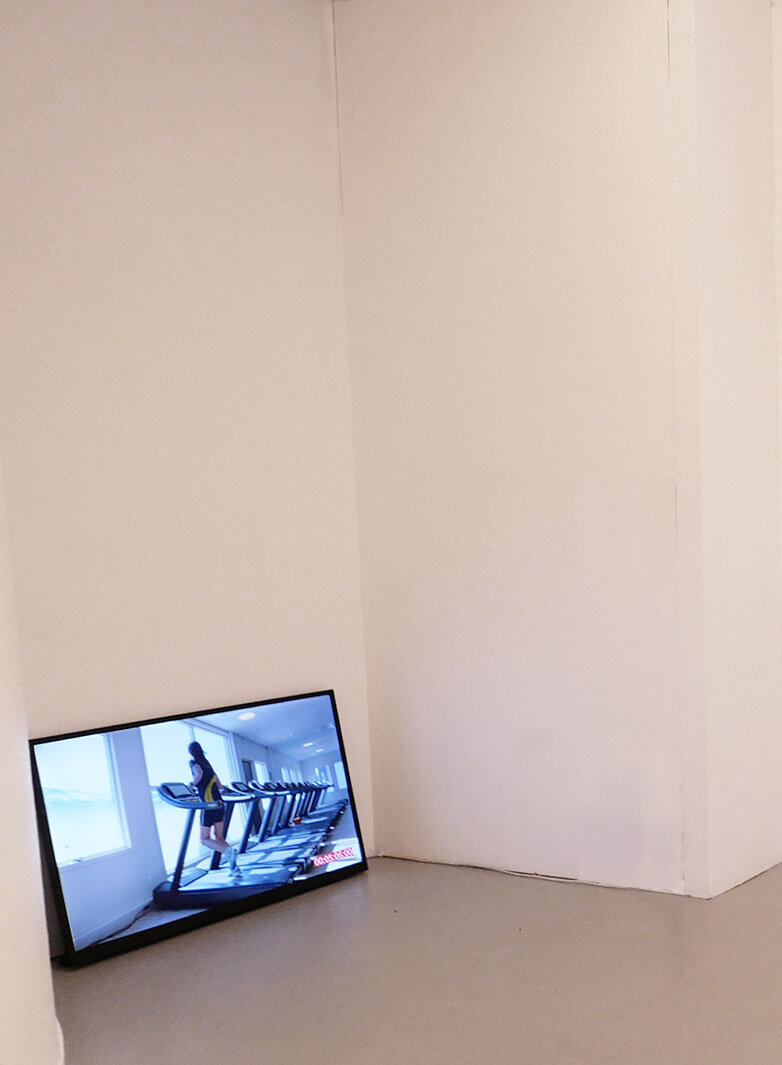Timely Pieces
Anne Lindgaard Møller, Eva Faché, Franzisca Siegrist, Susanne Irene Fjørtoft, Mihály Stefanovicz
28. November to 19. December 2020 Galleri Verkligheten Umeå
“In other words, the time continuum, everlasting change, is broken up into the tenses past, present, future, whereby past and future are antagonistic to each other as the no-longer and the not-yet only because of the presence of man, who himself has an “origin,” his birth, and an end, his death, and therefore stands at any given moment between them; this in-between is called the present. It is the insertion of man with his limited life span that transforms the continuously flowing stream of sheer change — which we can conceive of cyclically as well as in the form of rectilinear motion without ever being able to conceive of an absolute beginning or an absolute end — into time as we know it.” – Hannah Arendt
It seems apt, in this tragic, strange and disorienting period of the pandemic, to think of time in relation to human lifespan and the biblical number of people whose time has been shortened, as well as the seemingly slowing down of time as a consequence of our restricted freedom to move and to produce.
For centuries, women and men within the fields of science and the humanities attempted to find the answer to the true nature of time. Albert Einstein, during a lecture in 1922 where he presented his Relativity Theory, famously said that, “The time of the philosophers does not exist”. This led to a lifetime debate on the nature of time between him and the philosopher Henri Bergson, who was present during the lecture and was provoked by the bold statement. Einstein was content with the thinking that time was what clocks measured, believing in a spatial understanding of time. Suggesting that any other notion of time, including a philosophical one, was not real and not objective. He believed that for physicists, the distinction between the past, the present and the future, is just an illusion.
Bergson, on the other hand, wanted a notion of time that included the emergence of new things. He was in favor of a more human notion of time and suggested that without a prior human experience of time, clock would not have any purpose and would just be bits of machinery used for our amusement. He says time is action itself, the emergence of something new via action. While he did not question the theories that the physicists of that period presented, he believed that their concept and understanding of time is not complete.
“Timely Pieces” gathers together a group of artists whose practice touches upon the different ideas and experience of time.
Anne Lindgaard Møller is a Danish visual artist who lives and works in Tromsø. Her works are often site-responsive and take their point of departure in materiality and/or history of specific places. Process and transformation are important elements in her practice as well as language and storytelling. The shaping of her works is context-based and manifests in installations composed of moving images, photographs, text and sculptures.
In a recent work called “Sun Drawings”, sunlight and time are interdependently linked. For half a year, from January to July, the artist had blue papers placed on her studio windows, using the incoming sunlight as a tool to make images. The work is a personal and poetic investigation into the act of catching the ephemeral but also relates to the scientific method of data collection; the sun drawings have been exposed to the local weather, touched and marked by the atmospheric conditions. The traces have stuck to the paper, a reminder of the mutual relationship between us and nature, being affected by and being the one affecting.
Eva Faché is a Belgian photographer and photojournalist who acquired a bachelor’s degree in photography at Narafi, Brussels and an MA degree in photography at the Royal Academy of Arts, Ghent. She has been working in Amsterdam and Tromsø for the last two years. Inspired by a book of fairytales, myths and legends from the Arctic, which she found in her mother's library, Eva embarked on a project, which made her travel alone in the Arctic Circle between 2018 and 2019. There, her own sense of time gradually changed as she immersed herself into the lives and routines of the people and families she met randomly throughout her journey.
Her project “ A Soul That Roams the Other World”, took her to some very isolated places around the Arctic Circle and allowed for the possibility to experience the very intimate and private world of practitioners of modern-day shamanism. During this period she lived in a pace, which contrasted greatly with her life in Belgium and The Netherlands.
“Sketchwork on TIME” is a collaborative project between Franzisca Siegrist and Susanne Irene Fjørtoft. They have collaborated since 2009 and meet up to work or perform at least once a year. In their way of working they deal with the abstract topic of time in very concrete everyday settings. They look at how our daily life consists of rhythms and repetitions controlled by both our biological and cultural time and observe how these two are sometimes contrary to each other. The project is in many ways an investigation of our presence in the now and finds its shape through space, sculptural objects and performative actions. The video is presented as a documentation of the performance, rather than a video art work in itself.
Franzisca Siegrist is a visual artist, born in Switzerland, raised in Spain and living in Oslo. She has a degree in fine art from the University of La Laguna, Spain (Master 2008) with an exchange year in Product Design at the University of Akershus, Norway (2006), and also has a Master in Art Production at the University of Polytechnic in Valencia (2010) where she studied performance art under the Spanish artist Bartolomé Ferrando. She is co-founder and chair of PAO- Performance Art Oslo, has received several working grants and has in addition to other artistic work shown over 70 performances in Europe, in Asia and the USA.
Susanne Irene Fjørtoft is a Norwegian performance artist and scenographer who work both individually and in various collaborations. She studied visual arts at Ålesund School of Fine Arts and scenography at the Norwegian Theater Academy. Since 2009 she has created theater pieces, installations and performance art in the borderland between theater and visual art. Her work often becomes both aesthetic and conceptual with the intention of sharing both the personal and the universal with the audience.
The work “Document_6” is a time based scenario, staged in gyms and private apartments, Mihály Stefanovicz work with the atavistic act of running, and aiming to imply a post-modern, Jean Baudrillard inspired view on it. For the runner on the treadmill, landscapes are no longer any use, the soil is far outdated. The treadmill is perpetually turning without touching the ground, suspending the runner in virtual distance, eliminating the notion of a journey. The final goal is solely the ecstasy of fatigue, and the numbers documenting time and distance serve as the only proof of movement and progression.
Mihály Stefanovicz is a Hungarian visual artist, whose practice is predominantly based upon photo imagery and video work. He completed his bachelor’s degree at Royal Academy of Arts, The Hague (N.L.). He was trained in the craft of traditional photography, focusing on studio photography. Subsequently Mihály began to experiment with an action-based approach. He reduced the camera to be solely a tool of documentation. The act of repetition became the central element of his practice. He gained his MA degree at Tromsø Academy of Contemporary Art in 2020.
This exhibition received a grant from the Office for Contemporary Art Norway (OCA).



